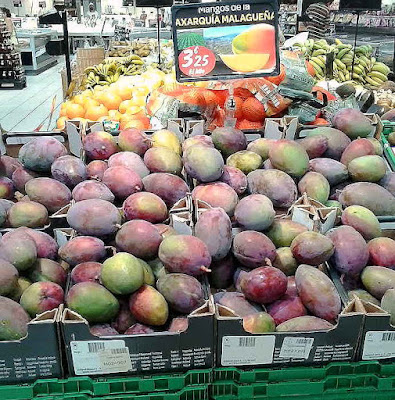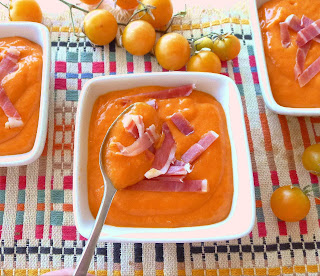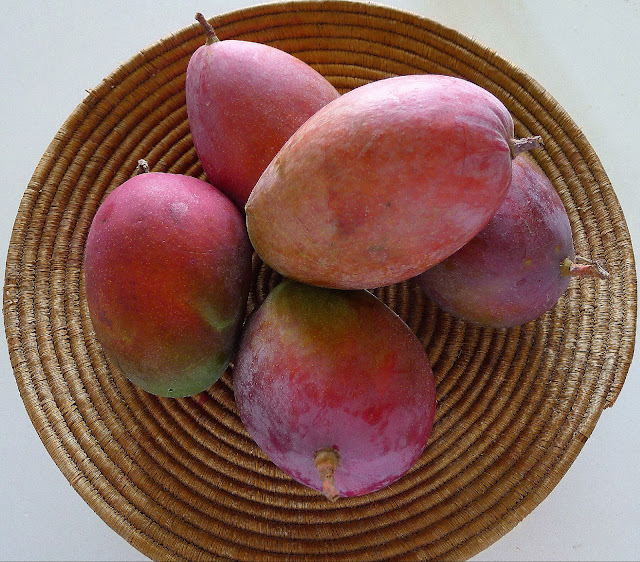 |
| A one-mango tree in my garden. |
In my garden is a small mango tree that finally delivered a single fruit. I picked it when it looked “ripe”—blushed with color—and allowed it to soften in the fruit bowl. Then I ate it all up. My mango was juicy, sweet and ever-so-fragrant. And quickly gone.
Luckily, it’s mango season in Málaga right now. I’m buying local fruit and using it in many ways, besides just eating it out-of-hand.
 |
| Locally-grown mangoes in a nearby supermarket. |
Mangoes are not native to Spain. In fact, they are very late arrivals. But the southern-most coast, east of the city of Málaga, enjoys a sub-tropical climate. Avocado plantations were established there back in the 1960s. Now mangoes are moving in, proving to need less water and produce more fruit per hectare* than avocados (one hectare produces 20,000 to 30,000 kilos of mangoes).
According to a recent newspaper report on this year’s harvest, the season will end in November with about 20 million kilos of mangoes.
Mangoes from Málaga enjoy an excellent reputation on the export market, as they are picked when sugar levels are high enough to assure good flavor. One of the main varieties is the Osteen. These crimson and green fruit have wonderful flavor and are not overly fibrous. These average about 15 ounces.
Indulging my mango mania, I found many ways to use them, most with a Spanish accent.
 |
| A traditional porra--thick gazpacho cream--made with mangoes as well as tomatoes. |
 |
| Paella rice with shrimp and mango sauté. |
 |
| Pan-fried ibérico pork chops with sautéed mango. |
 |
| Mango chutney goes with roast lamb. |
 |
| Pureed mangoes and yogurt for a gorgeous ice cream. (Recipe is here.) |
 |
| White sangría with mangoes. |
Mango-Tomato Gazpacho Cream
Porra Antequerana con Mango
Porra Antequerana con Mango
 |
| Porra is tradtionally garnished with strips of ham. |
Porra is the Málaga version of salmorejo, as it is known in Córdoba and Sevilla. It’s basically a very thick gazpacho of tomatoes, bread, garlic and olive oil, more of a cream than a soup. I’m jazzing it up by using mango as well as tomatoes and adding a bit of cumin and cayenne. The mango gives the porra a mysterious fruitiness.
Traditional porra is served garnished with serrano ham, canned tuna and/or chopped hard-boiled egg. Spanish ham seems especially good with the mango. Serve porra as a starter or light lunch.
Serves 4.
For a smooth gazpacho cream, either puree the tomatoes and sieve them or else peel the tomatoes.
Traditional porra is served garnished with serrano ham, canned tuna and/or chopped hard-boiled egg. Spanish ham seems especially good with the mango. Serve porra as a starter or light lunch.
Serves 4.
For a smooth gazpacho cream, either puree the tomatoes and sieve them or else peel the tomatoes.
 |
| Let bread soak up juices from tomatoes. |
2 cups cubed stale bread, crusts removed
2 cups peeled and chopped tomatoes
1 cup chopped mango
Salt
3 cloves garlic
¼ cup extra virgin olive oil
1 tablespoon Sherry vinegar
1/8 teaspoon cumin
Pinch of cayenne or pimentón picante (hot paprika)
Strips of serrano or ibérico ham, to garnish
Julienne strips of red and green pepper to garnish
Place the cubed bread in a blender. Add the tomatoes and mango and ½ teaspoon salt. Allow to stand at least 30 minutes, so the juice from tomatoes and mango begins to soften the bread.
Add the garlic and blend the bread, tomatoes and mango until smooth. With the blender running, add the oil, vinegar, cumin, cayenne and additional salt to taste (about ½ teaspoon). Chill the cream.
Serve the gazpacho cream in shallow bowls, garnished, as desired, with strips of ham, red and green pepper.
(Another recipe for “gazpacho cream” is here .)
2 cups peeled and chopped tomatoes
1 cup chopped mango
Salt
3 cloves garlic
¼ cup extra virgin olive oil
1 tablespoon Sherry vinegar
1/8 teaspoon cumin
Pinch of cayenne or pimentón picante (hot paprika)
Strips of serrano or ibérico ham, to garnish
Julienne strips of red and green pepper to garnish
Place the cubed bread in a blender. Add the tomatoes and mango and ½ teaspoon salt. Allow to stand at least 30 minutes, so the juice from tomatoes and mango begins to soften the bread.
Add the garlic and blend the bread, tomatoes and mango until smooth. With the blender running, add the oil, vinegar, cumin, cayenne and additional salt to taste (about ½ teaspoon). Chill the cream.
Serve the gazpacho cream in shallow bowls, garnished, as desired, with strips of ham, red and green pepper.
(Another recipe for “gazpacho cream” is here .)
Rice with Shrimp and Mango
Arroz con Langostinos y Mango
Arroz con Langostinos y Mango
 |
| Sautéed shrimp and mango tops savory paella-style rice. |
This is a paella-style rice. For dramatic effect, I used a par-boiled (“converted”) black rice. White rice is fine. Choose a round, medium-grain one, the sort used for paella.
If possible, start with whole shrimp with heads and tails (about 1 ¼ pounds). Peel the shrimp, reserving the bodies. Fry the shells and heads in 4 tablespoons olive oil. Skim out the shells and place them in a pan. Save the flavored oil for preparing the rice. Add 4 cups of water and 1 teaspoon salt to the shells and heads in the pan. Bring to a boil and simmer 30 minutes. Strain and reserve the broth for cooking the rice. (Discard the shells.) If you don’t have shrimp heads and shells for making broth, use chicken stock.
Use firm, slightly under-ripe mangoes for this dish.
Serves 4.
For the rice:
4 tablespoons olive oil (use oil that shrimp shells were fried in)
½ cup chopped red bell pepper
½ cup chopped green bell pepper
½ cup chopped onion
2 cloves chopped garlic
½ cup halved yellow cherry tomatoes
½ cup chopped zucchini
1 ½ cups converted rice
Pinch of saffron threads
¼ cup white wine
3 cups hot shrimp or chicken broth
Salt
Heat the oil in a paella pan or large skillet. Sauté the peppers, onion and garlic until softened. Add the tomatoes, zucchini and rice and sauté 3 minutes. Add the saffron and wine. Bring to a boil. Add the shrimp broth or chicken stock and salt to taste (if broth is salty, the rice may not need additional salt). Bring to a boil, then reduce heat and simmer until the rice is tender, 18-20 minutes.
For the shrimp and mango:
If possible, start with whole shrimp with heads and tails (about 1 ¼ pounds). Peel the shrimp, reserving the bodies. Fry the shells and heads in 4 tablespoons olive oil. Skim out the shells and place them in a pan. Save the flavored oil for preparing the rice. Add 4 cups of water and 1 teaspoon salt to the shells and heads in the pan. Bring to a boil and simmer 30 minutes. Strain and reserve the broth for cooking the rice. (Discard the shells.) If you don’t have shrimp heads and shells for making broth, use chicken stock.
Use firm, slightly under-ripe mangoes for this dish.
Serves 4.
For the rice:
4 tablespoons olive oil (use oil that shrimp shells were fried in)
½ cup chopped red bell pepper
½ cup chopped green bell pepper
½ cup chopped onion
2 cloves chopped garlic
½ cup halved yellow cherry tomatoes
½ cup chopped zucchini
1 ½ cups converted rice
Pinch of saffron threads
¼ cup white wine
3 cups hot shrimp or chicken broth
Salt
Heat the oil in a paella pan or large skillet. Sauté the peppers, onion and garlic until softened. Add the tomatoes, zucchini and rice and sauté 3 minutes. Add the saffron and wine. Bring to a boil. Add the shrimp broth or chicken stock and salt to taste (if broth is salty, the rice may not need additional salt). Bring to a boil, then reduce heat and simmer until the rice is tender, 18-20 minutes.
For the shrimp and mango:
1 tablespoon olive oil
1 clove garlic, sliced
Chile pepper, chopped, to taste
1 pound peeled, large shrimp
1 firm mango, peeled and sliced
Lemon slices to serve
Heat the oil in a medium skillet. Add the garlic. Before it browns, add the chile and shrimp and sauté, turning, until shrimp is pink. Add the sliced mango and sauté it briefly.
Spread the shrimp and mango on top of the rice. Garnish with sliced lemon.
1 clove garlic, sliced
Chile pepper, chopped, to taste
1 pound peeled, large shrimp
1 firm mango, peeled and sliced
Lemon slices to serve
Heat the oil in a medium skillet. Add the garlic. Before it browns, add the chile and shrimp and sauté, turning, until shrimp is pink. Add the sliced mango and sauté it briefly.
Spread the shrimp and mango on top of the rice. Garnish with sliced lemon.
Pan-Fried Pork Chops with Mango
Chuletas de Cerdo con Mango Salteado
Chuletas de Cerdo con Mango Salteado
 |
| Chunks of sweet mango sauté in the same pan as the chops. |
To cut-up mango: Slice it vertically off of the center pit. Cut the flesh diagonally without cutting through the skin. Push the skin side to open up the cuts, then cut the cubes free from the skin.
 |
| How to cut-up a mango. |
4 thick-cut loin pork chops
Salt and pepper
Sprigs of thyme
2 cloves chopped garlic
3 tablespoons olive oil
1 cup chopped mango
1/3 cup white wine
Season the pork chops with salt, pepper, thyme and garlic. Allow to stand for 30 minutes.
Heat the oil in a skillet and brown the chops on both sides. Remove to a plate. Add the mango slices to the skillet and brown them lightly. Add the wine and return the chops to the pan. Simmer until pork is just cooked through.
Salt and pepper
Sprigs of thyme
2 cloves chopped garlic
3 tablespoons olive oil
1 cup chopped mango
1/3 cup white wine
Season the pork chops with salt, pepper, thyme and garlic. Allow to stand for 30 minutes.
Heat the oil in a skillet and brown the chops on both sides. Remove to a plate. Add the mango slices to the skillet and brown them lightly. Add the wine and return the chops to the pan. Simmer until pork is just cooked through.
Mango Chutney
Salsa Chutney con Mango
Salsa Chutney con Mango
 |
| Chutney--a versatile condiment. |
Chutney is such a versatile condiment. Serve it with a holiday roast turkey, with roast lamb, on toasts spread with cream cheese.
I make chutney in small batches that keep in the fridge for a couple months. I use stevia, a sugar substitute, instead of sugar. The chutney doesn’t become as syrupy as it does with sugar.
2 cups chopped firm mangoes
1 cup chopped granny smith apple
1 cup chopped green tomato
1 cup chopped onion
¼ cup chopped red bell pepper
2 cloves chopped garlic
2 slices lemon, chopped
¼ cup seedless raisins
1 tablespoon chopped ginger
Chopped chile, to taste
½ teaspoon mustard seed
½ teaspoon coriander seed
1 teaspoon salt
1 ¼ cup white wine vinegar
1 cup sugar
Put all the ingredients in a pan. Bring to a boil, then simmer, uncovered, until fruits are tender. Ladle hot chutney into sterile jars and seal. When cool, refrigerate the jars.
I make chutney in small batches that keep in the fridge for a couple months. I use stevia, a sugar substitute, instead of sugar. The chutney doesn’t become as syrupy as it does with sugar.
2 cups chopped firm mangoes
1 cup chopped granny smith apple
1 cup chopped green tomato
1 cup chopped onion
¼ cup chopped red bell pepper
2 cloves chopped garlic
2 slices lemon, chopped
¼ cup seedless raisins
1 tablespoon chopped ginger
Chopped chile, to taste
½ teaspoon mustard seed
½ teaspoon coriander seed
1 teaspoon salt
1 ¼ cup white wine vinegar
1 cup sugar
Put all the ingredients in a pan. Bring to a boil, then simmer, uncovered, until fruits are tender. Ladle hot chutney into sterile jars and seal. When cool, refrigerate the jars.
White Wine Sangría with Mango
Sangría con Mango
Sangría con Mango
 |
| Macerate the fruit in sweet wine. |
When cutting up the mango, be sure to squeeze all the juice from the fibrous flesh surrounding the pit. Add the juice to the cut-up fruit. The fruit macerates in a sweet Pedro Ximenez Sherry (PX), so it does not need extra sugar.
1 ½ cups chopped mango
½ orange, sliced
1 slice lemon
Red currants or blueberries
1/3 cup PX Sherry
1 bottle chilled white wine
Soda water or lemon-line soda to taste
Sprig of lemon verbena (optional)
Ice cubes, as desired
Place the fruit in a pitcher and add the PX Sherry. Let the fruit macerate at least 30 minutes and up to 3 hours.
Immediately before serving, add the wine, fizzy water, lemon verbena, if using, and ice cubes.
1 ½ cups chopped mango
½ orange, sliced
1 slice lemon
Red currants or blueberries
1/3 cup PX Sherry
1 bottle chilled white wine
Soda water or lemon-line soda to taste
Sprig of lemon verbena (optional)
Ice cubes, as desired
Place the fruit in a pitcher and add the PX Sherry. Let the fruit macerate at least 30 minutes and up to 3 hours.
Immediately before serving, add the wine, fizzy water, lemon verbena, if using, and ice cubes.
*A hectare is a metric measurement equivalent to 10,000 square meters or 2,471 acres.

No comments:
Post a Comment